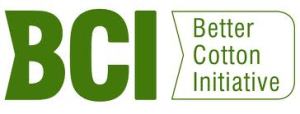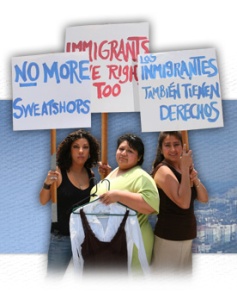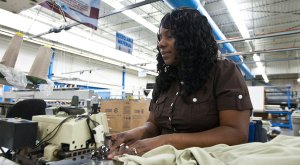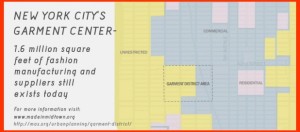“The Empowerment Plan is a humanitarian project based in the city of Detroit. The plan centers around a coat that is self-heated, waterproof, and transforms into a sleeping bag at night. The coat is made by a group of homeless women who have been paid to learn and to produce the coats for those living on the streets. The focus is on the system to create jobs for those that desire them and coats for those that need them at no cost. The importance is not with the product but with the people.”
PRODUCTION
Case #33: Goods of Conscience – Bronx
“Goods of Conscience provides work for people like Carmen who not only need to make ends meet, but want to learn a lasting skill and to take pride in their work. They also need to have the ability to be available to their families at any given notice.
When the garment says made in the Bronx, it is strengthening the community in many ways. Proceeds from sales are used to fund projects in the neighborhood:
*We teach kids to sew and act responsibly towards the environment. We teach them that “sustainability” saves lives.
*We fund marriage counseling and provide a Focus Test – a psychological inventory of the couple – to help couples cope with differences.
*We hold seminars to promote local gardening, home organization and cooking with locally produced food.”
CASE #28: Better Cotton Initiative
“BCI exists to make global cotton production better for the people who produce it, better for the environment it grows in and better for the sector’s future.
BCI works with a diverse range of stakeholders to promote measurable and continuing improvements for the environment, farming communities and the economies of cotton-producing areas.
BCI aims to transform cotton production worldwide by developing better cotton as a sustainable mainstream commodity”.
+ Information visit Better Cotton Initiative
CASE #26: Secondhand clothing
Made in LA [Documentary]
“Made in L.A. is an Emmy award-winning feature documentary that follows the remarkable story of three Latina immigrants working in Los Angeles garment sweatshops as they embark on a three-year odyssey to win basic labor protections from a trendy clothing retailer. In intimate verite style, Made in L.A. reveals the impact of the struggle on each woman’s life as they are gradually transformed by the experience. Compelling, humorous, deeply human,Made in L.A. is a story about immigration, the power of unity, and the courage it takes to find your voice”.
*Short clip from documentary
“In this documentary about used clothing, the historical memoir of a Jewish immigrant rag picker intertwines with the present-day story of ‘pepe’ — secondhand clothing that flows from North America to Haiti. Secondhand (Pepe) animates the materiality of recycled clothes — their secret afterlives and the unspoken connections among people in an era of globalization.
In the early 1900s, immigrant Jews from Eastern Europe collected, sorted, and sold secondhand clothing. As the Jewish peddlers made their way through North American city streets, they called out ‘Rags, Bones, Bottles!’ Today, at the beginning of the 21st century, the used clothing industry has gone global. Billions of pounds go to developing nations each year. Used American clothes play an especially central role in Haiti where, as one peddler reveals, ‘It’s all pepe, all the time.’
Dreamlike visuals and ethereal sounds intermix the beats of Jewish klezmer and Haitian rara music. Luke Fischbeck (Lucky Dragons) has composed the soundtrack of the film with an artful and nuanced ear, emphasizing the ruptures and looped connections among diasporic cultures. Secondhand (Pepe)’s two stories converge as American castoffs travel from the Jewish memoir reader’s rag factory to the Haitian shores. As pepe makes its way to Port-au-Prince, passing through an intricate network of peddlers, seamstresses and entrepreneurs, the past recycles into the present”.
CASE #25: ReMade in Leeds & Antiform
“ReMade in Leeds is a Leeds based sustainable fashion boutique offering workshops, events and clothing collections under our in-house brand, Antiform.
We offer sewing workshops designed to help you to make the most of your wardrobe, helping you to develop new skills in upcyling, garment repair and alterations.”
CASE #23: Tadashi Shoji
“Mr. Shoji is not a household name, but for years women whose silhouettes don’t conform to sample sizes have sought out his relatively affordable evening wear (his dresses retail for $400 to $900) at department stores like Neiman Marcus and Bloomingdale’s. A fan of stretchy, non-constrictive fabrics and patterns that prize comfort and wearability, Mr. Shoji does not discriminate against size or age. (His motto is “17 to 70.”) While most designers don’t deign to make a garment larger than a Size 10 or 12, Mr. Shoji’s pieces run up to Size 16, and, in some cases, 24 or “queen size,” as he puts it. ”
+ NYT article “Silhouettes Tailored to Every Woman”
CASE #22: SustainU
“SustainU, based in Morgantown, W.Va., uses all-recycled materials to make clothing for colleges and universities. As its name indicates, it is committed to ‘social, economic and environmental sustainability’ where blind workers are trained to complete specific tasks and are set up with adaptive equipment to help them do their jobs”
+ NYT-article “Hiring the Blind, While Making a Green Statement”
CASE #21: Save the Garment Center
Save the Garment Center’s mission is to Promote, Preserve, and Save New York City as Fashion Capital of the World
“Save the Garment Center is a trade association devoted to promoting New York’s Garment District, and the fashion companies or brands who use it. In 1960, 95% of clothing sold in the US was Made in the US. Now, that figure is down to just 5%. Despite this drastic decline, there are still 846 fashion companies headquartered in New York City which is more than London, Paris, and Milan combined. New York City is the Fashion Capital of the World, and the Garment Center continues to make that possible.
STGC promotes fashion companies and brands who design and produce quality clothing in the Garment District and in New York City. There are 24,000 apparel manufacturing jobs in New York City that make this domestic clothing production possible, and STGC creates transparent access to all of these resources for the future designers of America. These resources enable new fashion entrepreneurs to start a business and a fashion line leading to the creation of American jobs. Whether you are an established or emerging designer, a consumer, a fashion junkie, or simply a concerned American citizen, we ask you to join us in supporting New York’s Garment Center.
Save the Garment Center was started in 2007 as a grassroots campaign by factory owners Samanta Cortes, Anthony Lilore, Paul Cavazza and Larry Geffner. This campaign was in response to City Hall’s plans to lift the 1987 zoning laws that had protected the leases of the Garment Center fashion tenants for the past 23 years. Save the Garment Center’s initial goal was to keep the manufacturers and suppliers in New York’s Garment District from being pushed out of the district, or having to shut down all together. In 2009 Save the Garment Center became the 501c6 trade association it is today.
As a trade association, we support factories, suppliers, and designers through education and advocacy. We are ambassadors to all programs that support and create awareness for our members. There is no other Garment Center in the world like ours. The Garment Center is the soul of Midtown Manhattan, and the backbone of the NYC fashion industry”.
For + information visit :
CASE #20: The Sewing Rebellion
The Sewing Rebellion – An economic tactic for change in the apparel industry.
The Sewing Rebellion is a free workshop that began in Chicago in 2006. “Participants of the Sewing Rebellion are invited to emancipate themselves from the global garment industry by learning how to alter, mend and make their own garments and accessories! (…) encouraging the reuse, renovation and recycling of existing garments and textiles in the creation of unique items tailored to individual tastes and body shapes. Participants are asked to bring pants to mend, garments to alter, sewing problems which need solutions or and old piece of cloth to combat the use of plastic bags, by producing an East German shopping bag. Other knock off patterns on hand: hunters hat, and white-collar shirt.”
For + information: The Sewing Rebelion
CASE #17: Awamaki
“Awamaki is a Peruvian non-profit civil association and a U.S. 501(c)(3). These two organizations partner closely to work towards community development in and around Ollantaytambo, Cusco, Peru. Awamaki was formed in early 2009. It’s first and still-largest program is the weaving project, which serves the rural indigenous communities above Ollantaytambo. Since 2009, Awamaki has expanded to other women’s microenterprise crafts cooperatives, as well as programs in health, education and sustainable tourism. We at Awamaki believe that women’s economic access is a powerful driver of sustainable community development, but we recognize the crucial role that access to quality health care and education plays in increasing community well-being. We believe in close collaboration between local partners and world actors to best utilize resources for local good. We also believe that non-profit work is most sustainable when social enterprise is an integral part of an organization’s funding model, and we work to thoroughly incorporate social enterprise strategies into our activities. ”
+ AWAMAKI









